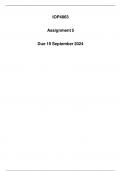IOP4863
Assignment 5
Due 19 September 2024
,PART A: PERSONNEL PSYCHOLOGY
1.1. The Difference Between Unfair Discrimination and Adverse Impact
Unfair Discrimination refers to the practice of treating individuals differently based
on attributes such as race, gender, age, or other protected characteristics, rather
than on individual merits or qualifications. Under South African law, unfair
discrimination is explicitly prohibited, with laws like the Employment Equity Act
emphasizing that individuals should not be disadvantaged due to characteristics
unrelated to job performance.
Adverse Impact, on the other hand, refers to practices that may appear neutral but
have a disproportionately negative effect on a particular group. For example, if a
selection procedure is used that seems fair but results in a significantly lower pass
rate for minority groups, it may be considered as having an adverse impact. Unlike
unfair discrimination, adverse impact does not involve intent to discriminate; instead,
it highlights the need for validation of selection processes to ensure they do not
unintentionally discriminate against protected groups.
, 1.2. The Complexity of Fairness in Employment Decisions
To understand the complexity of fairness in employment decisions, we refer to the
scatterplots presented in Cascio and Aguinis (2019). These figures illustrate different
relationships between predictors (such as test scores) and criteria (like job
performance), highlighting how certain predictor-criterion relationships can either
promote fairness or lead to adverse impacts.
1. Figure 8.1 shows a scenario with a positive linear relationship between
predictor and criterion, indicating that higher test scores are associated with
better job performance for all groups. This situation is legal and appropriate as
it does not show any adverse impact.




